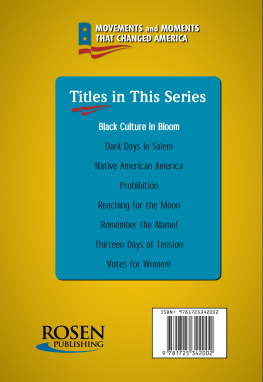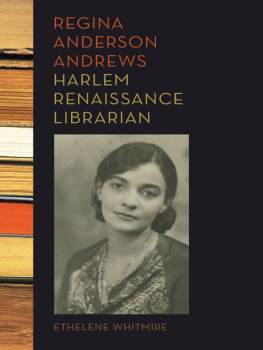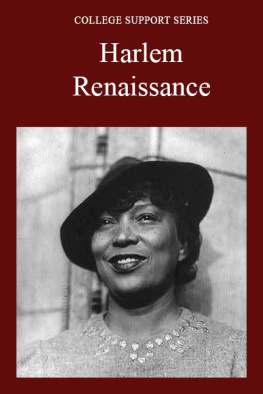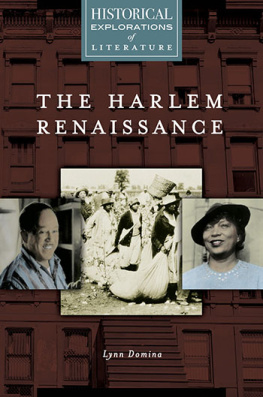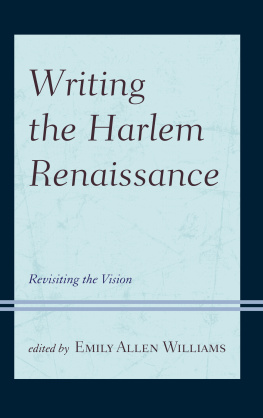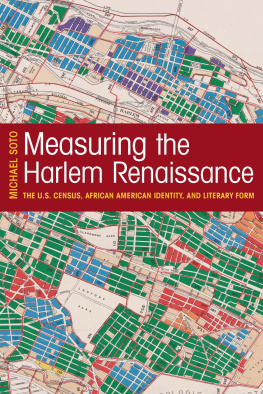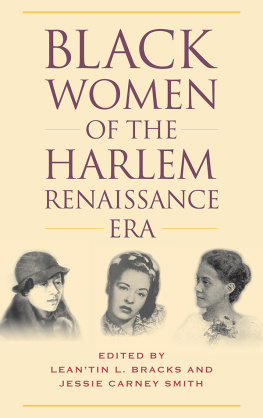Harlem Renaissance
Harlem Renaissance
UPDATED EDITION
NATHAN IRVIN HUGGINS
With a new foreword by Arnold Rampersad


Oxford University Press, Inc., publishes works that
further Oxford Universitys objective of excellence
in research, scholarship, and education.
Oxford New York
Auckland Cape Town Dar es Salaam Hong Kong Karachi
Kuala Lumpur Madrid Melbourne Mexico City Nairobi
New Delhi Shanghai Taipei Toronto
With offices in
Argentina Austria Brazil Chile Czech Republic France Greece
Guatemala Hungary Italy Japan Poland Portugal Singapore
South Korea Switzerland Thailand Turkey Ukraine Vietnam
Copyright 1971, 2007 by Oxford University Press, Inc.
First published by Oxford University Press, Inc., 1971
First issued as an Oxford University Press paperback, 1973
Updated edition published by Oxford University Press, Inc., 2007
198 Madison Avenue, New York, New York 10016
www.oup.com
Oxford is a registered trademark of Oxford University Press
All rights reserved. No part of this publication may be reproduced,
stored in a retrieval system, or transmitted, in any form or by any means,
electronic, mechanical, photocopying, recording, or otherwise,
without the prior permission of Oxford University Press.
Library of Congress Cataloging-in-Publication Data
Huggins, Nathan Irvin, 1927
Harlem Renaissance / Nathan Irvin Huggins ; with a new foreword by
Arnold Rampersad. Updated ed.
p. cm.
Includes bibliographical references and index.
ISBN 978-0-19-506336-3 (pbk.)
1. Harlem Renaissance. 2. African AmericansIntellectual life20th century. 3. African American arts20th century. 4. African AmericansNew York (State)New YorkIntellectual life20th century. 5. African American artsNew York (State)New York20th century. 6. Harlem (New York, N.Y.)Intellectual life20th century. 7. New York (N.Y.)Intellectual life20th century. 8. American literatureAfrican American authorsHistory and criticism. I. Title.
E185.6.H858 2007
305.5520899607307471dc22
2007004019
9 8 7 6 5 4 3 2 1
Printed in the United States of America
POEMS BY CLAUDE MCKAY
Africa, After the Winter, America, Baptism, If We Must Die, and To the White Fiends, from Selected Poems of Claude McKay (copyright 1953 by Bookman Associates, Inc.) are reprinted by permission of Twayne Publishers, Inc.
POEMS BY LANGSTON HUGHES
Advice, printed in Montage of a Dream Deferred, Henry Holt, Co. (copyright 1951 by Langston Hughes); and Advertisement for the Opening of the Waldorf Astoria, first printed in New Masses, January 1935 (copyright 1935 by Langston Hughes) are reprinted by permission of Harold Ober Associates. Dream Variations, Mother to Son, and The Negro Speaks of Rivers (copyright 1926 by Alfred A. Knopf, Inc., and renewed 1954 by Langston Hughes); Song for a Dark Girl (copyright 1927 by Alfred A. Knopf, Inc., and renewed 1955 by Langston Hughes); Black Maria and Hope (copyright 1942 and renewed 1970 by Arna Bontemps and George Houston Bass); and Afro-American Fragment (copyright 1959 by Langston Hughes) are reprinted from Selected Poems of Langston Hughes by permission of Alfred A. Knopf, Inc.
POEMS BY COUNTEE CULLEN
For John Keats, Apostle of Beauty, Harsh World that Lashest Me, Heritage, If You Should Go, Shroud of Color, Simon the Cyrenian Speaks, and Yet Do I Marvel (copyright 1925 by Harper & Row, Publishers, Inc., and renewed 1953 by Ida M. Cullen) are reprinted from Color by Countee Cullen by permission of Harper & Row, Publishers, Inc.
POEMS by STERLING BROWN
Lines from Memphis Blues published in Southern Road (copyright 1932 by Harcourt Brace & World) are reprinted by permission of the author.
POEMS by JEAN TOOMER
Song of the Son and Reapers from Cane by Jean Toomer (copyright (R) renewed 1951 by Jean Toomer) are reprinted by permission of Liveright Publishers Corp., New York.
Photographs of Billy Kersands poster; Bob Cole, James Weldon and J. Rosamund Johnson; and Fletcher Henderson which appeared in Langston Hughes and Milton Meltzer, Black Magic, A Pictorial History of the Negro in American Entertainment, Englewood Cliffs, N.J., Prentice-Hall, 1967, are reproduced here by permission of Milton Meltzer.
For Sue Bailey Thurman
Acknowledgments
I was helped in this book, in one way or another, by many people. I cannot thank them all on these pages, but I shall list a few with the briefest explanation of their assistance to me.
Henry F. May taught me a lot about the 1920s and American intellectual history. Kenneth M. Stampp first inspired me to do work in what is now called Afro-American history. Oscar Handlin opened my mind to social and cultural history. Howard Mumford Jones has been a friend to me in many ways, and he encouraged me to write this book when it was only a germ of an idea.
A summers research was made possible by a faculty grant from Lake Forest College in Illinois. Ernest Kaiser of the Schomburg Collection of the New York Public Library, Wendell Wray of the Countee Cullen Branch of the New York Public Library, Helen Willard of the Harvard Theatrical Collection of the Harvard College Library, and Donald Gallup of the Yale University Library were very generous with their time and most helpful to me. I have no individual name, but the staff at the Theatre Collection of the New York Public Library at the Lincoln Center for the Performing Arts was of help to me too. Mary Beattie Brady talked to me for hours about some of the participants in the Harmon Foundation art competitions in the 1920s.
I was able to interview many whose names appear in the book: Regina Andrews, A. Philip Randolph, Louise Thompson Patterson, Aaron Douglas. I talked at length with the late Max Eastman at his Marthas Vineyard home in the summer of 1969. Of course, I am very grateful for the time and assistance of all of them. Two whom I interviewed, however, call for a special word. Meta Warrick Fuller, whose active years as a sculptress reached back into the nineteenth century, was in her ninetyfirst year when I talked with her. Her mind was alert and her perceptions were sharp in what was to be the last year of her life. Langston Hughes came to Boston one April day to read his poems. It was a cool afternoon, but there was a golden sun that came through the windows of the Charles Street Meeting House. And Hughess ingenuousness warmed everybody as if he were a radiant sun. It was fitting that Langston Hughes should read his poetry from a pulpit that other great blacks had used: Frederick Douglass, Sojourner Truth. In the afterglow of that dayfar into the nighthe chainsmoked cigarettes and talked to me about the 1920s and all the people he thought wonderful (which was just about everybody). It could not have been more than ten days later that Langston Hughes was dead. I shall always regret that my mind and skills will not evoke in these pages the unrestricted gift of self that Hughess April day was in Boston. But then, so too, all of his artistic life was such a free gift.
My research problems and questions engaged colleagues and friends. Bruce Kellner was of great help to me in locating photographs by Carl Van Vechten and securing for me permission to use them. Two colleagues at the University of Massachusetts at Boston were of particular help. Suzanne Gassner challenged and prodded me about my arguments from psychological assumptions. She helped me to see more clearly than I would have some of the questions I attempted to answer in Chapter 6. Thomas N. Brown brought to my attention some of Eugene ONeills thoughts on the use of masks in theater. Other colleagues read or listened sympathetically and made useful suggestions: Leon Litwack, Lawrence Levine, Samuel Haber, Jane Johnson Benardette, Henry F. May.
Next page



